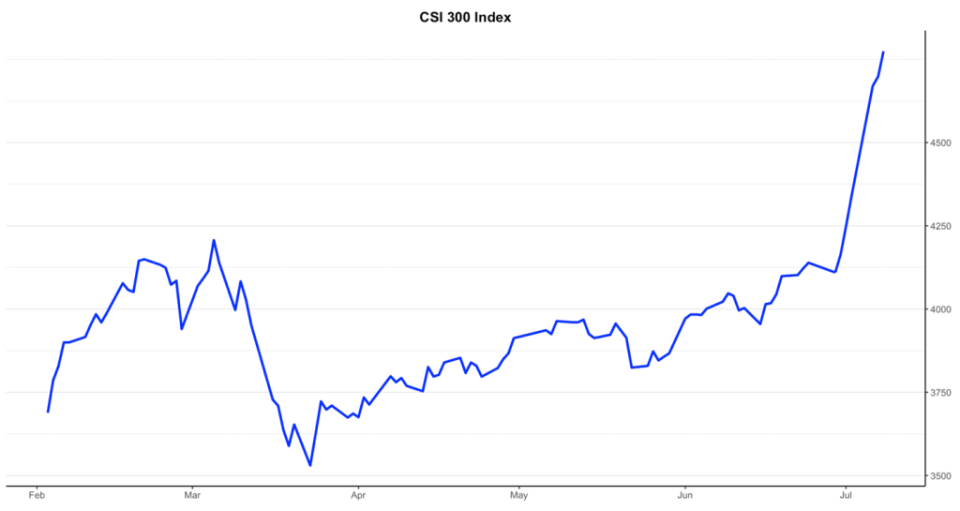Is the Chinese Stock Market Headed for a Repeat of the 2015 Crisis?

Chinese stocks shot up 6 percent on Monday, the largest single-day increase since the market began to rally in late March. The CSI 300 Index of the largest Chinese stocks has gained nearly 15 percent this month alone. While such a swing is not out of the ordinary for the notoriously volatile Chinese equity market, it raises concerns that China may be headed for a repeat of its 2015 stock-market crisis, when investors lost $1.6 trillion in a matter of days.

Graphic: Daniel Tenreiro
Then, as now, Chinese leaders cheered the rally on. In 2015, the state-media headlines said high equity prices reflected a “reform dividend” on new economic policies pushed by President Xi Jinping, while Premier Li Keqiang encouraged businesses to tap equity financing during the boom. This time around, Chinese leaders likely view the surge in stocks as a welcome vindication of their handling of the coronavirus. The state-owned China Securities Journal emphasized the importance of “fostering a healthy bull market” in a Monday editorial. Not to be outdone, Shanghai Securities News posted a story on WeChat with the headline “Hahahahaha! The signs of a bull market are becoming more and more obvious.”
While markets around the world are rallying despite the economic fallout from the pandemic, the numbers underpinning China’s surge give clear cause for concern. Trading volumes have jumped to their highest level since 2015, reflecting increased buying from retail investors. And the spread between Mainland-listed A-shares and Hong Kong–listed H-shares — called the A/H premium — has increased to 30 percent over the past month, its highest level in years.
The inflated value of Mainland-listed stocks is partially a consequence of the limited investment options for Chinese savers. A closed capital account and relatively undeveloped financial markets mean that stocks, property, and wealth-management products tend to offer the most attractive returns in China. Plummeting yields in money markets, coupled with recent losses in wealth-management products, have pushed Chinese savers back into equities, despite plummeting corporate profits. That Mainland investors are willing to pay more than their counterparts in Hong Kong for the same stocks indicates that the rally is rooted more in positive sentiment and loose monetary policy than in economic fundamentals.
In addition to driving investors away from low-yielding assets, Chinese monetary policy is driving a massive increase in leverage. Stock-exchange margin debt has risen to 1.16 trillion yuan ($164 billion), its highest level since 2015, according to Bloomberg. The 2015 crisis was triggered by a regulatory limit on the amount of margin that brokerages could provide their customers. Should Chinese regulators again close the spigots of leverage, equity markets could see a rapid sell-off.
Gavekal Economics’s Thomas Gatley points to policy changes as the biggest risk facing Chinese equity prices. While “today’s enthusiastic bull market seems to be driven primarily by expectations of ongoing policy support,” a recent increase in short-term rates by the People’s Bank of China (PBOC) suggests that such support is unlikely to persist.
Others see a potential economic justification for the bull market. Nomura strategist Masanari Takada wrote on Tuesday that the “wisdom of crowds may be manifesting itself as investors in mainland China’s equity markets become more confident about the prospect of sustained improvement in fundamentals.” Indeed, China’s Purchasing Manager’s Index showed a positive reading for June, and industrial profits rose 6 percent in May. But Takada was also quick to caution that the increased risk appetite of Chinese investors “makes it possible for even a small downward break in the trend to cause leverage to go into reverse, triggering a sell-off.”
Before the pandemic, Beijing had planned to move more household savings into financial markets in order to decrease the country’s reliance on loan financing. The China Banking and Insurance Regulatory Commission published a guideline in January saying it would “promote the conversion of household savings into long-term funds in capital markets.” The confluence of that long-term restructuring and an accommodative policy response to the coronavirus has driven equity prices close to their 2015 levels.
Meanwhile, China is facing currency pressures. The PBOC has recently kept the yuan’s daily fixing to the U.S. dollar above the spot-market level, a frequently used technique to prevent depreciation in the Chinese currency. While in the short-run the PBOC can buoy the yuan through market interventions, in the long-run it will likely need either to let the currency depreciate or to increase interest rates to reduce capital outflows. Whichever option it chooses, equity prices will suffer.
In 2015, when the stock-market crash appeared to have subsided, the PBOC decreased the yuan’s fixing to the dollar by 1.8 percent overnight. Investors promptly initiated a second round of selling, pricing in a major devaluation of the yuan that brought the stock market down by an additional $1 trillion. A similar dynamic could very well play out if traders continue to sell yuan.
That being said, the Chinese stock market remains small and insulated from global markets. China’s urban households hold only 11 percent of their wealth in financial assets, and restrictions on foreign investing reduce the spillover effects of China’s financial-market fluctuations. But if Chinese authorities alter currency valuations and interest rates to sustain inflated equity prices, they could deepen structural economic imbalances, increasing the risk of another crisis. And judging by news headlines, Beijing appears reluctant to let the rally subside.

